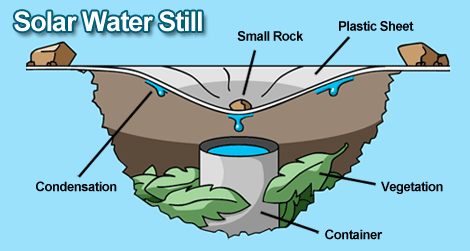All life on Earth requires water to survive. Without water a person could die in three days. When you are in a desert environment, finding water is number one priority for survival. But how do you find water in an environment that is known to have little to no water at all?
In many areas of a desert it is impossible to find water just because it isn’t there. However, there are parts of many deserts where hidden sources of water are at least seasonally available. In this post we will share you some tips on how to avoid dehydration in the desert.
What affects how much water you need?
Several factors affect a person´s water needs. Temperature, humidity, wind, sun intensity, clothing, physical condition, food intake, etc. To limit water loss it is a good idea to wear long pants, a shirt and a hat. When the skin is exposed to the air, the dry wind and heat can dehydrate the body quickly. A good way to conserve water reserves is to hike only during the night or cooler times of the day. Avoid the mid-day sun.
To limit water loss it is a good idea to wear long pants, a shirt and a hat.
Some desert landscapes contain canyons. These show evidence of water flow in times of heavy rains. If there is no water at the time, you can still use the north-face of the canyon walls to cool off your body.
Where to find water?
The first thing to do is to look for signs of life if you can´t find a water source. Vegetation, birds and insects can all mean a source of water nearby. Follow wildlife if possible as they always have access to water.
However, it is very unlikely to find water in the sand dunes. This makes deserts like the Sahara very hostile if you don´t carry water. If there are mountains nearby, there is a much better chance of locating water there. Sometimes the higher regions of these mountains may have some small patches of snow.
Other landscape characteristics that might be interesting are canyons. As mentioned before, these contain flowing water after a heavy rain. Your best chance to find some water is by following a canyon or wash up. Algae growing on the north side of rocks and moist sand provide more evidence of the presence of water.
Besides heading up, looking for lower terrain also is a good choice to find water as water flows down.
If you find moist sand, it is a good idea to start digging as there will probably be more water in the ground. You can do this with your hands, or by using a rock. If there is no water coming up at a depth of about 24-30 centimeters, move on.
Water flows down so look for low terrain. Canyons and mountain bases could be home to a water source.
Another thing to look out for is vegetation. Where there are living trees, there is water. Look for vegetation with the greenest leaves as here it is most likely to find water just below the surface. Since these springs come from deep underground, chances are very unlikely that it is contaminated by animal waste or insects carrying diseases.

Fishhook Barrel cactus: the only cactus you can drink water from
Also, roots all contain water. Cutting them open will release some liquid. Avoid drinking cactus water as it contains acids and potent alkaloids. It often appears as a cool survival tip, but if a cactus really was a big source of water in an environment where there is little to no water at all, it wouldn´t survive long with thirsty animals around. The truth is cactus water will give you diarrhea and make you vomit, which makes the dehydration worse. The exceptions to this rule are the prickly pear and one species of barrel cactus, the fishhook barrel (Ferocactus wislizeni). But this should only be last resort.
But, we know what you think. What if none of all of the above is available?
Extreme water finding techniques
If there is no vegetation, no canyons or mountains, then you are probably in a very hostile environment where there is almost no water at all. In this case you are depending on extreme water finding techniques. One of these techniques is collecting morning dew. This can be collected with a cloth or piece of clothing. Afterwards you can wring it out into your mouth. Make sure to do this before sunrise or it will evaporate before you have the chance to do so.
If you have a plastic bag, using it to cover a plant is also a way to collect condensation. An upgrade to this technique is by making a solar still.

How to drink water safely?
Water sources in the desert may be shared with wildlife. So there is a good chance, it contains bacteria. If possible, find a water source that is filtered naturally by rocks and sand. In other scenario´s it is best to make the water safe to drink by boiling it or filter it yourself. Read more about making water safe to drink here. However, if there is no way to purify it, and your choice is between drinking unfiltered water and dying of dehydration, take your chances.
Conclusion
When you are in the situation that you are lost in the desert with no water, there are a few things you can do to survive. If you know people are looking for you, throw away all this advice, look for a shady place and conserve your water reserves until you are resqued. Your quest for water would probably dehydrate you more than the little water you would find. If you are without help, look for shade in day-time and go look for water in the cool night. But remember, no matter how great it looks in survival shows, you are still in a desert, which means that finding water is not guaranteed.


